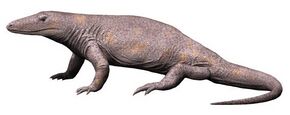Biology:Varanosaurus
| Varanosaurus | |
|---|---|

| |
| A reconstruction of Varanosaurus acutirostris | |
| Scientific classification | |
| Domain: | Eukaryota |
| Kingdom: | Animalia |
| Phylum: | Chordata |
| Clade: | Synapsida |
| Family: | †Ophiacodontidae |
| Genus: | †Varanosaurus Broili, 1904 |
| Type species | |
| †Varanosaurus acutirostris Broili, 1904
| |
| Species[1] | |
| |
Varanosaurus ('monitor lizard') is an extinct genus of early ophiacodontid synapsid that lived during the Artinskian[2] and Kungurian ages of the Permian.[3]
Description
As its name implies, Varanosaurus may have looked superficially similar to present-day monitor lizards[citation needed], though not related at all.
Varanosaurus had a flattened, elongated skull and a pointed snout with a row of sharp teeth, including two pairs of conspicuous pseudocanines, implying that it was an active predator.[4]
Varanosaurus probably lived in swamps, competing with the larger Ophiacodon for food.[citation needed]
Classification
Below is a cladogram modified from the analysis of Benson (2012):[5]
| ||||||||||||||||||||||||||||||||||||||||||||||||||||||||||||||||||||||
See also
References
- ↑ "Varanosaurus". http://www.fossilworks.org/cgi-bin/bridge.pl?a=taxonInfo&taxon_no=38933.
- ↑ A. S. Romer. 1937. New genera and species of pelycosaurian reptiles. Proceedings of the New England Zoölogical Club 16:89-95
- ↑ R. R. Reisz. 1986. Pelycosauria. Handbuch der Paläoherpetologie / Encyclopedia of Paleoherpetology 17A:1-102
- ↑ Palmer, D., ed (1999). The Marshall Illustrated Encyclopedia of Dinosaurs and Prehistoric Animals. London: Marshall Editions. p. 187. ISBN 978-1-84028-152-1.
- ↑ Benson, R.J. (2012). "Interrelationships of basal synapsids: cranial and postcranial morphological partitions suggest different topologies". Journal of Systematic Palaeontology 10 (4): 601–624. doi:10.1080/14772019.2011.631042.
Further reading
- Benes, Josef. Prehistoric Animals and Plants. Pg. 90. Artia: Prague, 1979.
Wikidata ☰ Q135536 entry
 |


